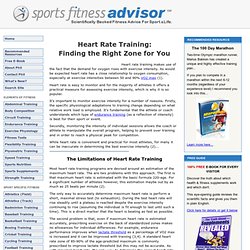

Physiologie de l'effort - Introduction. Basesphysio. Techniques de nage. Ressource Pédagogique - Natation.
How to determine target heartrate. The general formula for the average person is 220-age times 60% and times 90% of HRmax.

For example, a 30-year old would calculate his target zone using the above formula: 220-30=190. 190x.60=114 and 190x.90=171. This individual would try to keep his heartrate between 114 (low end) and 171 (high end) beats per minute. from Evelyn Mitchell efm@tummy.com The Karvonen Formula calculates your heartrate reserve range. To calculate it, take your pulse for one minute on three successive mornings upon waking up. (We will be using the case of a 30-year old male whose resting pulse was 69,70 and 71 for an average of 70 over the 3 days.)
Calculate target heartrate by subtracting your age from 220 (220-30=190). Subtract your average resting heart rate from target heartrate (190-70=120). The lower boundary of the percentage range is 50% of this plus your resting heart rate [(120 x .5) + 70 = 130]. Like the maximum heartrate formula, the Karvonen formula can vary from individual to individual. Heart Rate Training For Sport. Heart rate training makes use of the fact that the demand for oxygen rises with exercise intensity.

As would be expected heart rate has a close relationship to oxygen consumption, especially at exercise intensities between 50 and 90% VO2 max (1). Heart rate is easy to monitor and for the majority of athletes it offers a practical measure for assessing exercise intensity, which is why it is so popular. It's important to monitor exercise intensity for a number of reasons.
Firstly, the specific physiological adaptations to training change depending on what relative work load is employed. It's fundamental that the athlete or coach understands which type of endurance training (as a reflection of intensity) is best for their sport or event. Secondly, monitoring the intensity of individual sessions allows the coach or athlete to manipulate the overall program, helping to prevent over training and in order to reach a physical peak for competition. The Limitations of Heart Rate Training Equipment. Friskis&Svettis Brussels - Home. Anaerobic & Lactate Threshold Explained. If VO2 max is your aerobic endurance potential then your lactate threshold plays a significant role in how much of that potential you are tapping.

Lactate threshold has been defined as: The point during exercise of increasing intensity at which blood lactate begins to accumulate above resting levels, where lactate clearance is no longer able to keep up with lactate production. (3) During low intensity exercise, blood lactate remains at or near to resting levels.
As exercise intensity increases there comes a break point where blood lactate levels rise sharply (4,5). Researchers in the past have suggested that this signifies a significant shift from predominantly aerobic metabolism to predominantly anaerobic energy production. Several terms have been used to describe this shift and many coaches and athletes believe it is the same phenomenon: Lactate threshold Anaerobic threshold Aerobic thresholdOnset of blood lactate accumulation (OBLA) Maximal lactate steady state The 100 Day Marathon.